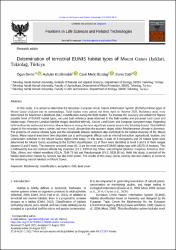| dc.contributor.author | Demir, Ogün | |
| dc.contributor.author | Kızılırmaklı, Aybüke | |
| dc.contributor.author | Bozdağ, Cavit Meriç | |
| dc.contributor.author | Cabi, Evren | |
| dc.date.accessioned | 2023-04-20T08:07:18Z | |
| dc.date.available | 2023-04-20T08:07:18Z | |
| dc.date.issued | 2022 | |
| dc.identifier.issn | 2718-062X | |
| dc.identifier.uri | https://doi.org/10.51753/flsrt.1109635 | |
| dc.identifier.uri | https://search.trdizin.gov.tr/yayin/detay/1118127 | |
| dc.identifier.uri | https://hdl.handle.net/20.500.11776/11228 | |
| dc.description.abstract | In this study, it is aimed to determine the terrestrial European Union Nature Information System (EUNIS) habitat types of Mount Ganos (Işıklar) and its surroundings. Field studies were carried out from April to October 2021. Reference areas were determined for Maximum Likelihood (ML) classification during the field studies. To increase the accuracy and obtain the highest possible level of EUNIS habitat types, we used both reference areas observed in the field studies and processed land cover and habitat maps. These are; Landsat Satellite Images classified with ML, Corine Land Cover, and European ecosystem maps. Regarding both biodiversity and social activities, Mount Ganos is among the most significant natural areas in the Tekirdağ district. The northern slopes of the mountain have a rainier and more humid climate than the southern slopes which Mediterranean climate is dominant. The presence of various climate types and the remarkable altitude variations also contribute to the habitat diversity of the Mount Ganos. Many natural areas have been degraded due to anthropogenic effects such as mineral extraction, agricultural, tourism, and urbanization activities in the Mount Ganos region until today. In this study, a total of 9 ecosystems and 29 habitat types were determined for Mount Ganos according to the EUNIS classification. 21 of them were identified at level 3 and 8 of them ranged between 2 and 6 levels. The intensive unmixed crops (I1.1) are the most-covered EUNIS habitat type with 16173.16 hectares. This is followed by low and medium altitude hay meadows (E2.2, 9350.63 ha), Meso- and eutrophic Quercus, Carpinus, Fraxinus, Acer, Tilia, Ulmus, and related woodland (G1.A, 7548.73 ha) and Pseudomaquis (F5.3, 5926.65 ha). With this study, a portrait of the habitat destruction created by humans has also been drawn. The results of this study can be used by decision-makers to conserve the remaining natural habitats on Mount Ganos. | en_US |
| dc.language.iso | eng | en_US |
| dc.identifier.doi | 10.51753/flsrt.1109635 | |
| dc.rights | info:eu-repo/semantics/openAccess | en_US |
| dc.subject | Biodiversity | en_US |
| dc.subject | classification | en_US |
| dc.subject | ecosystem | en_US |
| dc.subject | GIS | en_US |
| dc.subject | land cover | en_US |
| dc.title | Determination of terrestrial EUNIS habitat types of Mount Ganos (Işıklar), Tekirdağ, Türkiye | en_US |
| dc.type | article | en_US |
| dc.relation.ispartof | Frontiers in Life Sciences and Related Technologies (Online) | en_US |
| dc.department | Fakülteler, Fen Edebiyat Fakültesi, Biyoloji Bölümü | en_US |
| dc.identifier.volume | 3 | en_US |
| dc.identifier.issue | 2 | en_US |
| dc.identifier.startpage | 69 | en_US |
| dc.identifier.endpage | 74 | en_US |
| dc.institutionauthor | Demir, Ogün | |
| dc.institutionauthor | Kızılırmaklı, Aybüke | |
| dc.institutionauthor | Bozdağ, Cavit Meriç | |
| dc.institutionauthor | Cabi, Evren | |
| dc.relation.publicationcategory | Makale - Ulusal Hakemli Dergi - Kurum Öğretim Elemanı | en_US |
| dc.identifier.trdizinid | 1118127 | en_US |



















